
medieval.org
Raum Klang 9901
Raum Klang "Souvenir" 59901
1999
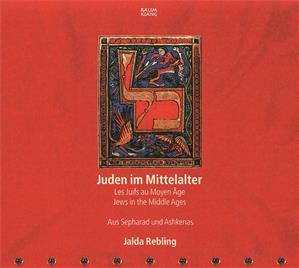

medieval.org
Raum Klang 9901
Raum Klang "Souvenir" 59901
1999

1. Waedamah [4:14]
Text: final line of a Piyyut of unknown origin
Music: Obadiah (~ 1100)
“And I wept and I spoke under the gates and the community taught me.”
This
piece was written by Obadiah. Born in Oppido, Lucano (Italy) as
Iohannes, he was the son of a Norman aristocrat named Dreux. Shortly
after having taken the vows to become a catholic priest, he converted to
Judaism (~ 1102), as a consequence of a dream he experienced. His
varied life took him on travels through Constantinople, Baghdad and
Aleppo to North Palestine and finally via Tyre to Egypt, where he then
settled in Fostat. During these years he studied intensively and became
renowned as a scholar. All his works, including his autobiography, were
found in the Cairo Geniza. (The Hebrew word “geniza” refers to a place set aside for the storage of ritually inappropriate documents.)
2. Shir ha—Shirim [3:35]
Text: Song of Songs III/1
Music: Improvisation
“By night on my bed I sought him whom my soul loveth: I sought him but/found him not”
3. Ki mi—Zion teze Torah [1:01]
Text: Isaiah II/3
Music: Improvisation
“For the Torah emerges from Zion and God's word from Jerusalem.”
All
the improvisations recorded here are based on the torah tropes noted
down by Johannes Reuchlin in the sixteenth century. These tropes cannot
carry meaning as such like a word. The idea is for them to subdivide a
long sentence into smaller logical units and their function is therefore
to serve both the dramaturgy and syntax. In principle, even these
melodic cells, depicted graphically by, for example, a dot or a loop,
can be exchanged.(As such, they differ from neumes, which try to pin
down a musical event.) The flexibility of the tropes therefore explains
regional differences in their execution and also allows entirely new
melodies to be created. However, the presence of an underlying tonal,
functional structure is prerequisite and is usually provided by the
interval of a fourth or a fifth, a factor that again links the tradition
with that of Gregorian chant.
4. Mi al Har Horev [4:34]
Text: Piyyut by “Amr”
Music: Obadiah
“Who was as strong and sure in his belief as was Moses on Mount Horeb?”
The
author of this piyyut was “Amr”, according to an acrostic using these
letters in the text. The piyyut was intended for use during the two
holidays Shawuot and Simhat Torah: both are festivals which celebrate,
at different moments of the Jewish calendar, the reception of the Torah
at Mount Horeb. The people, and thus every individual, receives the
Torah, which is therefore not solely transmitted through Moses. However,
according to the text, nobody can compare himself to Moses. There are
neumes for this piyyut, which were written down by Obadiah and are read,
like the text, from right to left.
5. Adonai ma Adam [4:40]
Text: Shlomo Ibn Gabirol (1028-1058)
Music: anonymous
“What is man, Oh Lord? Were not he from flesh and blood, his days would pass like shadows and would go unnoticed.”
6. Barukh ha—Gever [2:47]
Text: Jeremiah, Proverbs, Job
Music: Obadiah
“Blessed is the man who trusts in God.”
7. Kevarim [3:54]
Text: Moses Ibn Ezra (1055-1139)
Music: anonymous
“Graves
from ages long past and in them lies a people as old as the world and
no Hatred and no Envy in them and no Love and no Hatred for the other.
And it is impossible to distinguish the servant from the master.”
Ibn
Ezra, born in Granada, was one of the most prolific poets of his time.
He held an important position in Granada and witnessed the assault by
the Almoravids in 1090, through which the entire Jewish community of the
town was destroyed. After the assault, he fled to the Christian part of
Spain, an area in which he then remained but always felt a stranger.
8. Shir ha—Shirim [3:18]
Text: Song of Songs III/4
Music: Improvisation
“Scarcely had I passed them when I found him whom my soul loveth.”
9. Le mi Anuss [3:08]
Text: Isaac Ha-Gorni (13th century)
Music: Contrafactum to “Ja nuns hons pris” ascribed to Richard the Lionheart (1157-1199)
“Woe
betide him who is in despair and cannot find support as, alas, is poor
Gorni who receives only in mockery and deprecation who is without money
and support. Perhaps my fate is my heritage and my wealth and misery my
pillar.”
Isaac
ben Abraham Ha-Gorni from Aire in the South West of France chose to
express himself in Hebrew. According to contemporary witnesses, Gorni
never settled down and was eternally dependent upon masters. Throughout
his journeys to all the important centres of southern France in the 13th
century, he frequently complained about the shallowness of the culture
and the narrow-mindedness of the inhabitants. Unsurprisingly, this often
caused conflict with his contemporaries and fellow poets, like Abraham
Bedersi of Perpignan who replied with poetic mockery. Gorni's literary
testament is full of sarcasm and bitterness and is one of the most
unusual examples of medieval poetry.
10. Quant voi les oisiaus esjoir [3:03]
Text: Robert de Blois (13th century)
Music: Contrafactum to “Onque del beverage ne bai” by Chrétien de Troyes (fl. ~ 1160-1190)
“When I hear the birds rejoicing over the sweetness of the season, I then sing their song to numb my pain.”
Trouvere song
11. [6:42]
Merci douce Dame
Text: Mathieu le Juif (13th century)
Music: Contrafactum to “Bien doit chanter”, anonymous (13th century)
“I
beg thee, show mercy with me, my, sweet Lady, for with thee I have not
brought guilt upon myself. For thee have I forsaken my covenant and my
belief in God against the will of my friends, and thou art making a fool
out of me. Thou hast betrayed me, as they have taught thee.”
Et s'autrement ne puis
Text: ibid
Music: Contrafactum to “Mon caret mi”, anonymous (13th century)
“And
if I cannot gain thy love, then may God make her so old and shrivelled
that the whole world, other than I, hates her. And then I would know
whether she would become a slave to me.”
12. Swer adellîchen tuot [1:51]
Text: Süskind von Trimberg (~ 1200-1250)
Music: Contrafactum to “Aspis ein wurm geheizen is”,
ascribed to Konrad von Würzburg (1220/30-1287)
“Whoever
acts in decency I wish to call noble. One can no more recognise
nobility from recorded lineage, than the rose by the thorn. And where
men violate virtue's duties, there the robes of nobility fall into mere
pieces. Yet he who is upright and does his duty, he who needs no name
but honours virtue, him I call noble, even were he not of noble origin.”
Süskind
von Trimberg, a German minstrel of Franconian origin, is the only
German medieval poet known to have devoted his attention to Jewish
subjects. Hardly anything is known about his life.
13. [4:37]
Küng Herre, hochgelopter Got
Text: Süskind von Trimberg
Music: Contrafactum to “Sit man daz bone bi den guoten”,
by Rumslant (fl. 1273-1286)
“King,
Lord, highly praised God, all power rests in you. You lighten up with
the day and darken with the night. You grant us joy and rest. In you all
beauty is revealed and all you create will remain for eternity”
Ir manes krone
Text and Music: ibid.
“A
virtuous wife is a man's crown. What she possesses honours him: purity
in body and soul. Fortunate is he whom she assists and who spends year
after year in joy with her! To her highest praise have/made this song.”
14. Gedenke nieman kann erwern [2:37]
Text: Süskind von Trimberg
Music: Contrafactum to “Nu merke ho un edle man”,
by Friedrich von Sonnenburg († before 1287)
“Thoughts
are refused neither the foolish nor the wise. They are free to move
where they will, no matter whom they are meant for. Nothing can keep
them, neither stone, nor steel, nor iron. Thoughts are the possession of
man, as are heart and mind, no matter whether they then ripen into
action. One senses them, but cannot grasp them.”
15. Re'e Shemesh [2:00]
Text: Shlomo Ibn Gabirol (1020-1058)
Music: traditional sephardic
“See
the sun, how red it is when night falls, as if immersed in the purple
of a worm. You spread out towards North and South, and the wind of the
sea you cover with purple. And the earth, she is bare and naked. She
rests under the shadow of night, seeking shelter. The clouds darken in
deep grief over dear Yekutiel.”
16. Shir ha-Shirim [2:06]
Text: Song of Songs V/6,7
Music: Improvisation
“My
soul was in terror because he had turned away. I searched for him but I
found him not. I cried out for him but he gave no answer. The guards
who walk about the city found me and beat me until I was sore.”
17. [6:09]
Ir me quiero a Yerushalayim /
Ir me queria yo por este caminico
Text and Music: sephardic
“I
want to leave, mother, I want to go to Jerusalem. Night falls and yet
the dawn is upon us. Jerusalem, mother, which I see before me, grants me
light, like the waxing moon. In the holy temple is a seven-armed
menorah, which illuminates the world. In the holy temple three doves
fly. They converse with the Shekhina face to face.”
Libi be'Misrakh
Text: Jehuda HaLevi (1080-1145)
“My
heart is in the East, yet I am on the other side of the West. How may I
taste it, the nourishment, how may I value it? How shall I fulfil all
my oaths, my commandments, whilst Zion is caught in the ropes of Edom
and I myself am chained to the West? With such ease would I leave
prosperous Spain behind, for so dear is the sight of the extinguished
ashes of the Holy of Holies.”
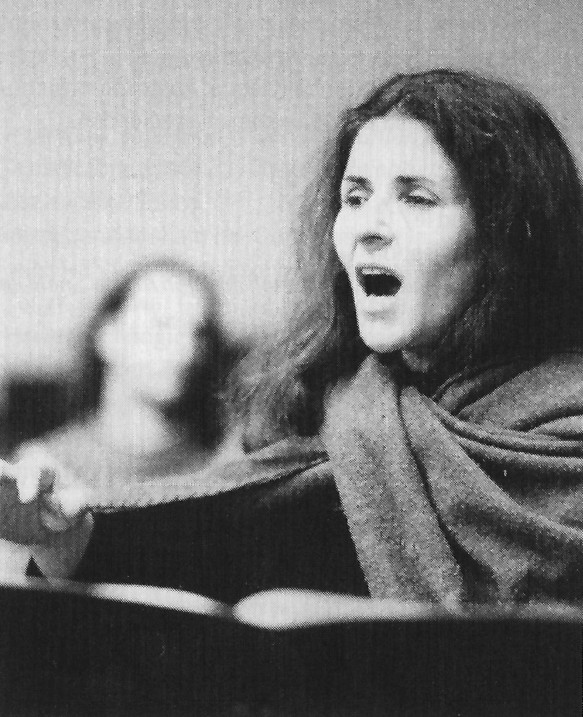
Jalda Rebling — Gesang
Hans-Werner Apel und Stefan Maass — Laute
Susanne Ansorg — Fidel
Sabine Heller— Harfe
Veit Heller — Portativ
Michael Metzler — Percussion

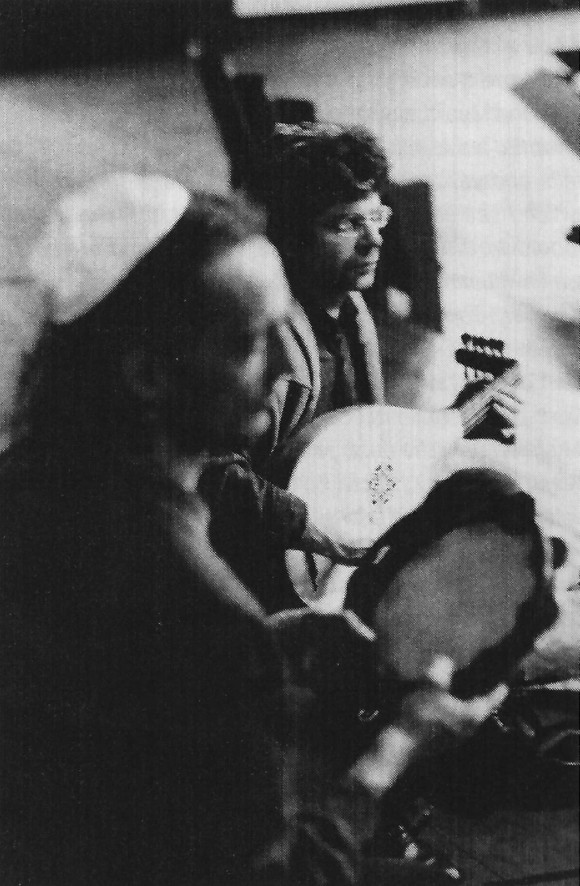 Translation: Jessica Marshall
Translation: Jessica Marshall
All texts in Hebrew, French and Middle High German can be found at the following internet address: www.raumklang.de
Wir danken der Synagogengemeinde Rykestraße und der
Jüdischen Gemeinde zu Berlin, daß sie diese Aufnahme
ermöglichten.
Wir bedanken uns bei Dr. Hanna Liss für ihre umfangreichen Recherchen.
Wir danken Prof. Karl E. Grözinger für seinen Rat.
Und wir danken Prof. Henning Schroeder für seine Beratung.
Die Aufnahmen fanden vom 2.-5. Februar 1999 in der Synagoge Rykestraße/Berlin Prenzlauer Berg statt.
Tonaufnahme und Schnitt: Sebastian Pank
Gestaltung/Satz: KOCMOC.NET Kathleen Rothe
Redaktion: Susanne Ansorg
Musikerfotografien: Silke Helmerdig
Alle Abbildungen stammen aus: L' art juif, Éditions Citadelles & Mazenod, Paris 1995.
Titelseite: Titelblatt des Gebetes Kol Nidre. Ritualbuch, Bodenseeraum, um 1320. (34,5 x 24,5 cm)
RKs 59901
© und ℗ Raumklang 1999
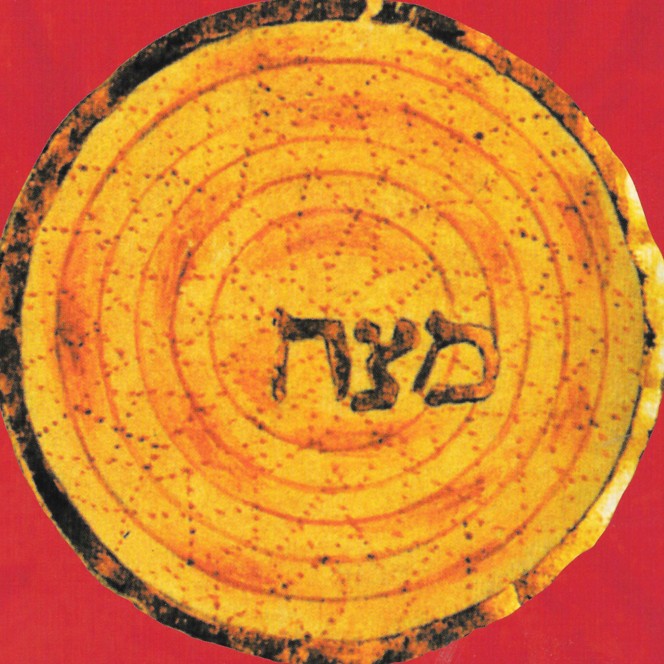
European Jewry
Whether or
not the names Mathieu le Juif and Süskind von Trimberg actually stand
for historically proven figures, their poetry mirrors the state of mind
of specific parts of European Jewry in the Middle Ages.
The term
"Middle Ages" covers a diverse period, which encompasses an equally
diverse society. This society had to reorientate itself as "Europe"
after the collapse of the Roman Empire. Polycentrism replaced central
administration, causing severe problems. The Middle Ages darkened due,
at least from our modern point of view, to the consequences of these
crises, coupled with the image of the Middle Ages created by scholars in
the nineteenth century. Temporal distance makes the whole appear
simpler and more aestheticized than it actually was, and any picture of
the Middle Ages brings with it an ominous element - anti-Semitism, as
hatred of Jews is now being called. The ultimate consequences of this
development are to be found in the unfortunate 1930s and 1940s. With the
image of these years in mind, it is actually possible to talk about a
contemporary, dark "Middle Ages" - those allegedly responsible are not
inhabitants of the real Middle Ages, but representatives of the present.
Seen from this perspective, one could say that since the 1940s Europe
has been trying gradually to re-find the twentieth, that is to say it's
own, century.
To return to the real Middle Ages, Mathieu le Juif
converted to Christianity and experienced his new isolationary existence
as a catastrophe, whilst Süskind of Trimberg remained committed to
Judaism and felt himself to be equally isolated as a result of the
expulsion and homelessness imposed on him by a judaeophobic environment.
The
Jews of Moorish Spain, known as Sephardim, who formed the other great
Jewish society, were also not safe from discrimination and persecution
by their Islamic rulers. However, they enjoyed comparative freedom: as
non-Christians they did not present a direct challenge to the regime;
they did not represent Christian States or kings with missionary
ambitions. Moreover, well-versed in other languages, Sephardic Jews
mediated between classical antiquity and a young, Islamic society
thirsting for knowledge. Whilst Ashkenazim (i.e. German Jews) were
excluded from guilds and societies and barred from taking public office,
Sephardim held positions in universities and even in the civil service,
thereby becoming the first Jewish "aristocrats" of modern times. But
there were both Ashkenazic and Sephardic poets and thinkers, despite the
sometimes oppressive-conditions for Jews in Christian Central Europe.
Poets and thinkers can be found amongst these speakers of Middle High
German, Jewish German and French as long as the illusion remains, which
is to say, until they were consumed by the fires of persecution. Both
Sephardim and Ashkenazim were strongly influenced by their immediate
environment and in this respect are comparable with any other minority.
They used local poetic forms and adopted languages and melodies, thereby
giving Jewishness every different character in different parts of
Europe. But a common underlying basis, and indeed that which links
Central Europe Jewry with that of the Meïterranean and the Middle East,
is provided by the Torah (the five Books of Moses), the Talmud (a very
rich literature of responsa), and a language, which next to Ladino,
Jewish German and Jewish Arabic serves as a universal language: Hebrew.
The language of the Torah.
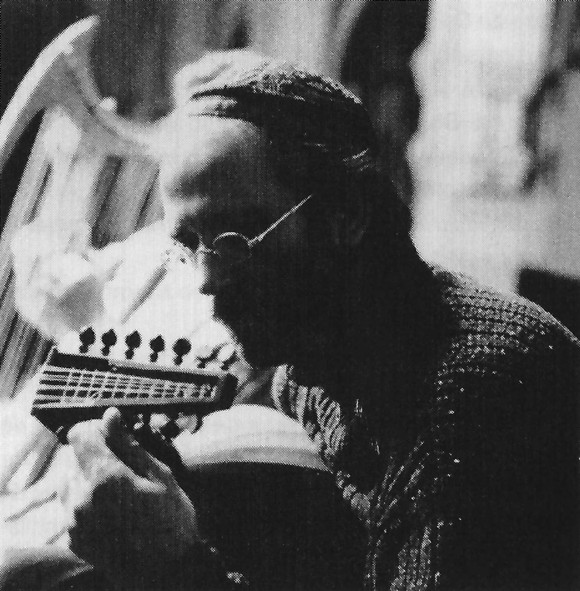 For the past two hundred years the
study of Hebrew for the pupils of Cheder, for example, has begun in a
highly sensual manner: the teacher drips honey on each letter, so that
the language to be learnt becomes at the same time a matter of physical
importance and, most certainly, a matter of the heart. Furthermore, each
individual letter and the language itself in general, is dealt with in
every conceivable way. Each word and grammatical function is examined
and defined from every possible angle. So, being accompanied by a
benediction and therefore receiving linguistic explication, each act is
fully explored and defined in detail - a blind man could follow the
events.
For the past two hundred years the
study of Hebrew for the pupils of Cheder, for example, has begun in a
highly sensual manner: the teacher drips honey on each letter, so that
the language to be learnt becomes at the same time a matter of physical
importance and, most certainly, a matter of the heart. Furthermore, each
individual letter and the language itself in general, is dealt with in
every conceivable way. Each word and grammatical function is examined
and defined from every possible angle. So, being accompanied by a
benediction and therefore receiving linguistic explication, each act is
fully explored and defined in detail - a blind man could follow the
events.
The "sensuality" of the letters explains their position
in relation to music. Unlike the Christian mass, a synagogue service has
never developed into a musical genre. This may largely be due to the
enormous difficulties the Jews experienced in trying to integrate with
society, but was possibly also a consequence of their own anxious
isolation. Even though language is always a translation, a translation
of an inner event, it appears to be more objective and unambiguous than
music. (Yet, music plays a very important role in every society, not
only when reciting a text in front of a large group of people. The
singing voice carries the text further than the speaking voice would
allow.) However, in the long term, this may also have been influenced by
the views of the interpreters of Judaism, bearing in mind that
discussions of the role of music in Jewish society permeate the Middle
Ages. On the one hand, the rabbinical view was that music distracts from
the essential, by giving pleasure whilst listening and in particular,
by its capacity to arouse excessive human passions. On the other hand,
the cabalists argued that music is an essential part of the text, able
to provide meaning beyond words.
For the Hasidei Aschkenas,
German mystics of the 13th century, a melody was a prerequisite to any
expression of the love of God and the joy of the commandments. Music for
them provided the basis of the Kavvanah (concentration), serving to
deepen the concentration of the cantor in particular. For that reason
Yehuda He-Chassid, in the thirteenth century book Safer Hassidim, says
that one should select the melody for a text according to one's own
preferences. Most of the songs on this record were created according to
this principle.
The only authentic musical material belongs to
the songs of Obadiah. These pieces, notated in neumes, lay undiscovered
until 1763, when they were found in the Cairo Geniza, an outstanding
source of knowledge of the life of medieval European Jewry. As a Jewish
convert, Obadja illustrates the fact that there were indeed Christians
converting to Judaism, if only up until the time of the Crusades and
great plagues. There are no indications of rhythm or dynamic in the
source, so the text itself and it's speech rhythms are used as
guidelines for this recording. For the rest of the songs, the melodies
reflect the preference of the ensemble and were, whenever possible,
chosen for their contemporaneity with and topographical nearness to the
texts. In addition, when using popular songs, the theme of the original
text was also taken into account. For example, the song "Libi
be'Misrakh" is a lamentation of the poet who suffers because he is far
away from Jerusalem. The melody to this text is taken from the song "Ir
me quiero a Yerushalayim". The poems are linked by the yearning for
Jerusalem. The technique applied here is called contrafactum and is far
from uncommon. Indeed, examples of contrafactum are found throughout the
history of music and there are many reasons for it's use. A popular
melody is often utilised for new poetic creation, enabling a new song to
be learnt more quickly - a technique that is of particular interest to
the clergy when, for example, a text should gain speedy and wide
acceptance.
The care taken with the interpretation and the
efforts to create an awareness of human existence through language are
above all directed towards one single place, towards Jerusalem.
Jerusalem is the former city of the Temple, where the Schekhina, God's
presence on earth, dwells; the place from which the Jews were exiled by
the Romans in 70 CE, following the destruction of their centre, the
Temple. Since that time, all hope has been invested in the Messiah, who
will come and rebuild the temple. This hope takes on very different
appearances over the centuries, a major factor being the increasing
temporal distance from the traumatic events.
This longing has a
name; how it manifests itself is another matter. In the "Iggeret Teman",
a letter to the Jews of Yemen (written whilst they were in a state of
confusion over one of the many messianic appearances), Maimonides wrote
that people should no longer orientate themselves towards a return to
Jerusalem. This letter was certainly intended as a sedative, meant to
prevent both the disintegration of Jewish society and an uprising in the
Yemenite community. However, it illustrates the rejection of the idea
of a concrete return to Jerusalem in favour of the city and temple
becoming a symbol of greatness, which can be called hope.
This
unquieted but alive hope releases great strength. A poem like the one
already mentioned, "Libi be'Misrakh", is written to expresses the
anxiety, grief and despair of the poet who is far from Jerusalem. It
emphasises the nature of the relationship, acknowledging the importance
of the individual and the object of his desire, but stressing the
relationship or exchange between the two. Jerusalem can thus be a
direction to which the Jew turns in prayer — an act which further refers
to God. In this way, the relationship is like the one between the lover
and his beloved in the Song of Songs.
Esther Kontarsky
Translation: Jessica Marshall
